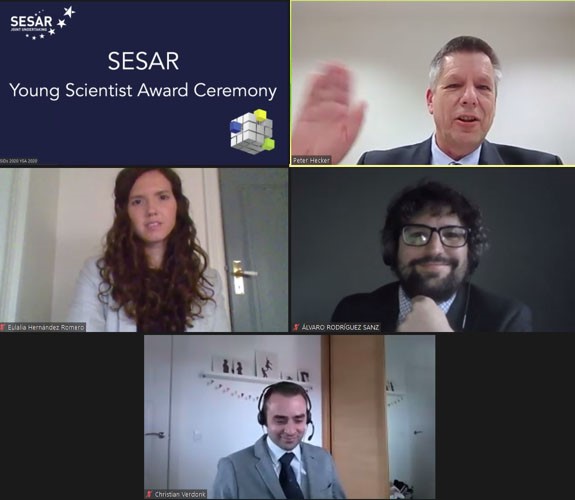
The ATM academic community needs to listen to controllers, pilots and airspace managers that run the system to ensure that their research is relevant to what’s actually happening on the ground, says Christian Eduardo Verdonk Gallego, CRIDA, and winner of the SESAR Young Scientist Award. In this interview, he shares what winning the prize means for him and the lessons we can learn from COVID.
What drew you to research and more specifically to ATM research?
I am a curious person, and that’s probably what brought me to research. I used to dream of working in a top technology industry, and in my mind it was aviation. So I began my studies in aerospace engineering. Then I started an internship at CRIDA, in Madrid, and that’s how my journey in ATM research started.
We faced at that time complex challenges. I considered that starting a PhD at the Universidad Politécnica de Madrid would provide me with those extra skills that are necessary to address them.
Why do you feel researching ATM is so important to European society and economy?
The European project has advanced so much that we, European citizens, take air travel for granted. As such, air transport is an enabler for fostering research, cultural and economic exchanges within our continent. We need to keep caring about it. The pandemic has taught us some harsh lessons, and one might be that we need to maintain the safety of air transport, from all angles, as a basic requirement for its viability as a business. That’s only possible through a continuous investment in research and innovation.
You were awarded the 2020 SESAR Young Scientist Award for your work into data-driven trajectory prediction - Can you tell us a bit about that work?
Understanding the trajectory lies at the core of ATM. An aircraft does not fly isolated, it flies within an ecosystem. To do so requires better harnessing the available data and understanding the factors impacting aircraft trajectories. That includes not only traditional ones such as weather, but the underlying operation of the ATM system and its operators, among them air traffic controllers. This is what I set out to do in my research. I made use of data and exploited controller cognitive strategies in order to identify potential aircraft interactions and then generate a network of trajectory predictors.
What does winning the Young Scientist Award mean for your career development?
Winning the award has been incredible! The recognition was instantaneous and worldwide. One of the award’s aims is raise visibility, and I am sure that it is going to boost my opportunities to collaborate with colleagues all over Europe, which I am really looking forward to.
Is European air traffic management moving with the times?
The European effort towards innovation in ATM through SESAR is providing benefits for its overall performance, not only in terms of safety or efficiency, but also on environmental terms. The benefits brought by free route in terms of horizontal efficiency benefits not only the airlines but also brings with a significant reduction in emissions.
In addition, ATM is moving towards increased levels of digitalisation, automation, and virtualisation, which require huge efforts by all actors in our ecosystem to move forward in the modernisation of the ATM system through innovation.
Are there developments taking place in other sectors that we should be closely following or even replicating?
It is always good to look at what’s going on in other sectors – it sometimes reveals unexpected things! For example, I am coordinating a SESAR Exploratory Research project, FARO, which is evaluating the resilience of ATM system with different use cases, such as the healthcare sector. In addition, we along with the rest of ATM’s academia are fully embracing artificial intelligence, which is evolving very fast.
Is COVID changing the direction of research in ATM?
For sure we will need to re-evaluate our targets, at least in terms of traffic forecasts for 2035. Sadly, aviation is suffering from the pandemic, and we have already seen that it has accelerated some structural changes. The pandemic is impacting the tempo of the world, and that will have consequences for the priorities in air transport, and hence, research in ATM.
What advice would you give other researchers starting out or interested in the field?
I would say that we need to listen more to the ATM practitioners. When I talk with air traffic controllers, pilots, safety practitioners, airspace managers, in summary, the professionals that run our system, I can feel their passion. We, as researchers, should aim at trying to bridge the gap between the operational and the pure academic world, and for that, we need to listen carefully to them, as best-placed observers of the system.
While the basic concept of trajectory prediction has been extensively studied, the 2020 SESAR Young Scientist Award jury commended Verdonk Gallego for adopting state-of-the art approach, broadening the scope of data and operational factors that impact the trajectory and looking at the wider air transport system.
“I want to congratulate all the applicants, short-listed candidates, and Christian Gallego, our overall winner. The fresh thinking that Christian brings to his research and the collaborative spirit he demonstrates through his participation in numerous SESAR projects, makes him an asset for the ATM community,” said Florian Guillermet, Executive Director of the SESAR Joint Undertaking. “Seeing the talent displayed during this year’s SESAR Innovation Days, I am confident that we can deliver innovative solutions to build a smart and sustainable aviation for generations to come!”

